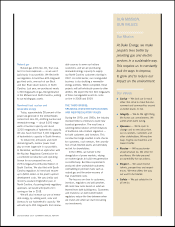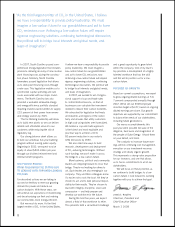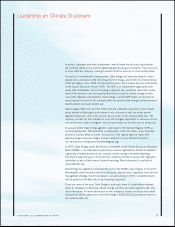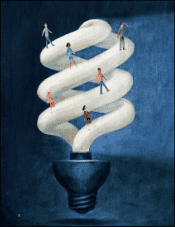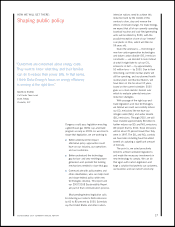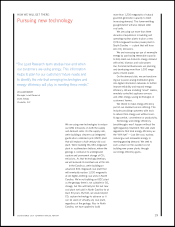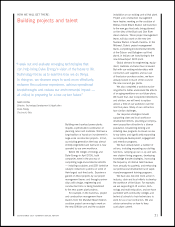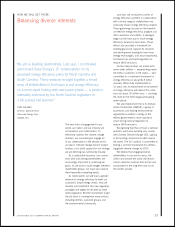Duke Energy 2007 Annual Report Download - page 19
Download and view the complete annual report
Please find page 19 of the 2007 Duke Energy annual report below. You can navigate through the pages in the report by either clicking on the pages listed below, or by using the keyword search tool below to find specific information within the annual report.
DUKE ENERGY 2007 SUMMARY ANNUAL REPORT 17
“Customers are concerned about energy costs.
They want to know what they and their families
can do to reduce their power bills. In that sense,
I think Duke Energy’s focus on energy efficiency
is coming at the right time.”
MARITZA RIVERA
Call Center Team Lead
Duke Energy
Charlotte, N.C.
Congress could pass legislation enacting
a greenhouse gas (GHG) cap-and-trade
program as early as 2009. As we strive to
shape that legislation, we are working to:
Better understand the impact
alternative policy approaches could
have on our industry, our operations
and our customers.
Better understand the technology
gap for low- and zero-emitting power
generation and promote the funding
mechanisms needed to close that gap.
Communicate with policymakers and
other stakeholders, who can help mold
and shape federal policy while new
technologies develop. This report and
our 2007|2008 Sustainability Report
are part of that communication process.
Most pending federal legislation calls
for reducing our nation’s GHG emissions
by 60 to 80 percent by 2050. Scientists
say the United States and other carbon-
■
■
■
intensive nations need to achieve this
reduction level by the middle of this
century to slow, stop and reverse the
effects of climate change. For Duke Energy,
we expect that all of our currently operating
baseload nuclear and coal-fired generating
units will be retired by 2050, with the
possible exception of one of our “newest”
coal plants in Ohio, which will then be
59 years old.
Given the unknowns — the timing of
new low-carbon generation technologies
and future carbon dioxide (CO2) emission
constraints — we decided to look instead
at what it might take to cut our CO2
emissions in half — by approximately
50 million tons — by 2030. Due to their
relicensing, our three nuclear plants will
still be operating, and our planned fourth
nuclear plant, Lee Nuclear Station, will
have been on line for about 12 years,
based on the current schedule. 2030
gives us a more realistic horizon over
which to evaluate potential emission-
reduction strategies.
With passage of the right cap-and-
trade legislation and new technologies,
we believe we could successfully reduce
our CO2 emissions like we have our
nitrogen oxide (NOX) and sulfur dioxide
(SO2) emissions. Through 2010, we will
have invested approximately $5 billion to
further reduce our SO2 and NOX emissions.
We project that by 2010, those emissions
will be about 70 percent lower than they
were in 1997. The SO2 and NOX controls
we have been installing have the added
benefit of capturing a significant amount
of mercury.
The point is, we acted proactively
before to achieve workable regulations
and made the necessary investments in
new technology to comply. We can do
that again with carbon legislation and
forge a solution that protects our customers,
our business and our nation’s economy.
HOW WE WILL GET THERE:
Shaping public policy


